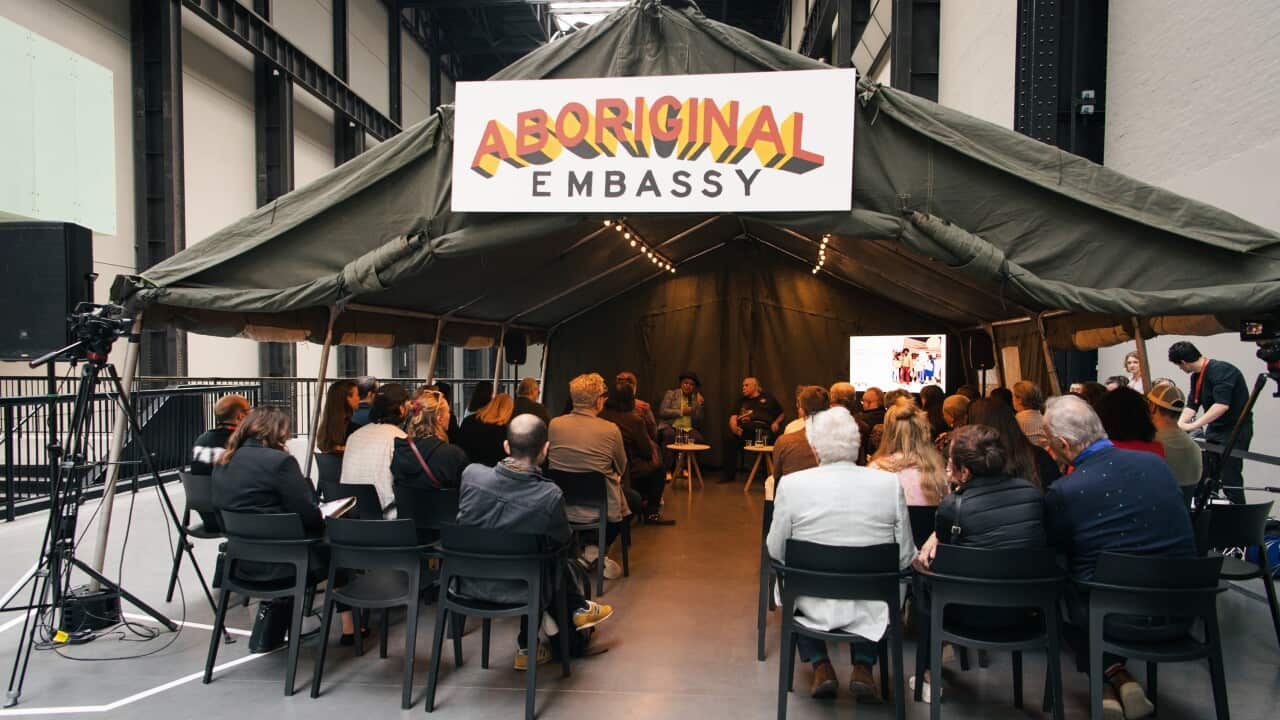It started with a beach umbrella.
Pitched on , four activists set up the Aboriginal Tent Embassy and made international headlines.
Now, Richard Bell’s replica of the famous protest, entitled 'Embassy', has taken up residency at London's Tate Gallery in the midst of the British Empire, or as he calls it: "the heart of the beast".
So how was the work received at one of the Empire's most prestigious galleries?
"Well nobody came and bagged it to my face!” Bell laughs.
The display has travelled around the world for a decade, but this year an opportunity to show 'Embassy' in London came by express invitation from the Tate Modern. Fittingly, it has been set up in the gallery's Turbine Hall, which has hosted some of the world’s most acclaimed works of contemporary art.
Just as its inspiration has since its inception, 'Embassy' aims to provoke powerful conversations and protest.

Richard Bell's art installation is a space that brings together activists from around the world. Credit: Tate Modern, Richard Bell, Aboriginal Embassy, 2023 © Tate (Jordan Anderson
Bell, a Kamilaroi, Kooma, Jiman and Gurang Gurang man, says the display is as relevant today as it was back when he started because of the connection through conversation the Embassy facilitates - just as the original intended.
“I think people like the format and the intimacy the space brings,” says Bell.
“Everything is so electronic these days… zoom meetings, telephone calls… sitting with other people makes it attractive.”
Honouring a legacy
Over the course of a week 'Embassy' featured talks with First Nations communities from around the world, and also special guests from home, including original tent embassy members.
Euahlayi man Ghillar Michael Anderson and Quandamooka artist Megan Cope joined Bell, as well as Alan Michelson a New York-based artist and member of the Mohawk of the Six Nations of the Grand River; Sylvia McAdam Saysewahum from the Cree Nation, an advocate for First Nations and environmental rights in Canada; and Gumbaynggirr woman, Aretha Brown, an artist and activist breaking new ground in the space – just to name a few.
They were also joined by local London activists from the Black Power movement of the 70s and 80s.

Euahlayi man, Ghillar Michael Anderson, was one of the activists who established the original Aboriginal Tent Embassy and was a special guest during the week of events. Credit: Jordan Anderson
“It was surreal to be in the heart of the beast, that was, that is the British Empire and to be able to have these discussions with local people,” Bell said.
“One of the things I try to do with Embassy is give a voice to the local people, because so often the local voices are ignored everywhere.
"That’s a sad thing, so I tried to give voice to all these people who are not heard in their own cities.”
Passing the torch
Bell says ‘Embassy’ pays tribute young Blak activists as much as the pioneers who first took to the lawns of Parliament House on Ngunnawal land. He says he’s a “great supporter of the next generation of activists.”
“I started Embassy as a tribute to the young activists today who are setting up Aboriginal Tent Embassies around the Country,” says Bell.
“It’s obviously a tribute to the original tent embassy, but I had the idea to do this because in 2009, 2010, 2011, 2012, young Aboriginal people around the country were setting up embassies, and not just in the big cities, in small country towns and I thought that was phenomenal. This work is a tribute to those actions.”
Despite being a pioneer himself, Bell says he doesn’t have advice for the next generation.
He says he has trust in those rising up and from where he’s sitting, they’re doing an exceptional job.
Looking ahead, Bell says he hopes to one day set up a foundation and a residency program for young artists.
In the meantime, he will continue to create a space for voices to be heard, here and around the world.













